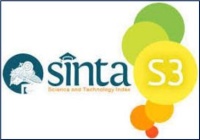Formulasi Masker Peel Off Gel dari Kombinasi Minyak Atsiri Sereh dan Cengkeh untuk Menghambat Bakteri Penyebab Jerawat
Abstract
Acne is a chronic skin disease involving inflammation of the pilosebaceous units with the main bacteria Staphylococcus epidermidis and Propionibacterium acnes has prompted the creation of cosmetic masks containing antibacterial agents. This study aims to evaluate the antibacterial activity of Lemongrass and Clove essential oils and to determine the synergistic effects of combining these essential oils in a peel-off gel mask formulation. The study was conducted using the liquid dilution method to determine the minimum inhibitory concentration and the disk diffusion method to test the inhibition zone diameter. Additionally, tests are conducted to determine the antibacterial activity against Propionibacterium acnes and Staphylococcus epidermidis, as well as to analyse the stability of the product both chemically and physically during storage. The results of the study showed that (1) the formulation containing a combination of 25% lemongrass and 18% cloves showed high inhibitory power and good stability, but caused moderate irritation; (2) lemongrass and clove essential oils were effective against Propionibacterium acnes and Staphylococcus epidermidis, but it was recommended to reduce the active ingredients to prevent potential irritation.
Keywords
Full Text:
PDFReferences
Apriani, E. F., Miksusanti, M., & Fransiska, N. (2022). Formulation And Optimization Peel-Off Gel Mask with Polyvinyl Alcohol and Gelatin Based Using Factorial Design from Banana Peel Flour (Musa paradisiaca L) As Antioxidant. Indonesian Journal of Pharmacy.
Birade, P., & Shete, Y. (2024). Formulation and Evaluation of Herbal Peel Off Mask: Research Article. Journal of Pharma Insights and Research, 2(1), Article 1.
Dasawanti, Y., Reveny, J., & Sumaiyah, S. (2022). Formulation And Evaluation Of Nanoemulgel Clove Leaf Oil (Sygyzium Aromaticum) (L.) Merr & Perry As Anti-Acne. International Journal of Science, Technology & Management, 3(6), Article 6. https://doi.org/10.46729/ijstm.v3i6.681
Kim, H. E., & Kim, Y. S. (2021). Inhibitory effects of cinnamon, clove and
lemongrass essential oils against biofilm formation by food poisoning bacteria. Journal of Food Hygiene and Safety, 36(5), 430-439.
Kim, C., Park, J., Lee, H., Hwang, D.-Y., Park, S. H., & Lee, H. (2022). Evaluation of the EtOAc Extract of Lemongrass (Cymbopogon citratus) as a Potential Skincare Cosmetic Material for Acne Vulgaris. Journal of Microbiology and Biotechnology, 32(5), 594–601. https://doi.org/10.4014/jmb.2201.01037
Listyanto, H. A., I. M. Muhammad, T. Erfianti, A. P. Herida, H. P.
Kusumaningrum, B. D. Loka, and E. Setyowati. "DNA isolation of clove and lemongrass using modification of the Doyle and Doyle methods and their relation with antioxidant activity." In Journal of Physics: Conference Series, vol. 1943, no. 1, p. 012081. IOP Publishing, 2021.
Leung, A. K., Barankin, B., Lam, J. M., Leong, K. F., & Hon, K. L. (2021). Dermatology: How to manage acne vulgaris. Drugs in Context, 10, 2021-8–6. 6
Misar, K. S., Kulkarni, S. B., & Gurnule, W. B. (2020). Formulation and evaluation of antiacne cream by using Clove oil. Materials Today: Proceedings, 29, 1251–1258. https://doi.org/10.1016/j.matpr.2020.06.106
Mustarichie, R., Sulistyaningsih, S., & Runadi, D. (2020). Antibacterial Activity Test of Extracts and Fractions of Cassava Leaves (Manihot esculenta Crantz) against Clinical Isolates of Staphylococcus epidermidis and Propionibacterium acnes Causing Acne. International Journal of Microbiology, 2020, e1975904. https://doi.org/10.1155/2020/1975904
Oladeji, O. S., Adelowo, F. E., Ayodele, D. T., & Odelade, K. A. (2019). Phytochemistry and pharmacological activities of Cymbopogon citratus: A review. Scientific African, 6, e00137.
Pan, D., Machado, L., Bica, C. G., Machado, A. K., Steffani, J. A., & Cadoná, F. C. (2022). In vitro evaluation of antioxidant and anticancer activity of lemongrass(Cymbopogon citratus (DC) Stapf). Nutrition and Cancer, 74(4), 1474-1488.
Peraturan BPOM No. 10 Tahun 2022. (n.d.). Database Peraturan | JDIH BPK. Retrieved May 4, 2024, from http://peraturan.bpk.go.id/Details/223969/peraturan-bpom-no-10-tahun-2022
Rum, I. A., & Suherman, H. W. (2021). Idar. Formulation and evaluation of peel-off gel mask from whole milk yogurt and seaweed (Eucheuma cottonii) as antioxidants sources. Pharm Pharmacol Int J, 9(4), 132-135.
Sharma, K., Guleria, S., Razdan, V. K., & Babu, V. (2020). Synergistic antioxidant and antimicrobial activities of essential oils of some selected medicinal plants in combination and with synthetic compounds. Industrial Crops and Products, 154, 112569. https://doi.org/10.1016/j.indcrop.2020.112569
Ulanowska, M., & Olas, B. (2021). Biological properties and prospects for the application of eugenol—a review. International journal of molecular sciences, 22(7), 3671.
Valdivieso-Ugarte, M., Gomez-Llorente, C., Plaza-Díaz, J., & Gil, Á. (2019). Antimicrobial, Antioxidant, and Immunomodulatory Properties of Essential Oils: A Systematic Review. Nutrients, 11(11), Article 11. https://doi.org/10.3390/nu11112786
Valizadeh, A., Khaleghi, A. A., Alipanah, H., Zarenezhad, E., & Osanloo, M. (2021). Anticarcinogenic effect of chitosan nanoparticles containing syzygium aromaticum essential oil or eugenol toward breast and skin cancer cell lines. BioNanoScience, 11(3), 678-686.
DOI: https://doi.org/10.33394/bioscientist.v12i2.11497
Refbacks
- There are currently no refbacks.

This work is licensed under a Creative Commons Attribution-ShareAlike 4.0 International License.

Bioscientist : Jurnal Ilmiah Biologi is licensed under a Creative Commons Attribution-ShareAlike 4.0 International License
Editorial Address: Pemuda Street No. 59A, Catur Building Floor I, Mataram City, West Nusa Tenggara Province, Indonesia











